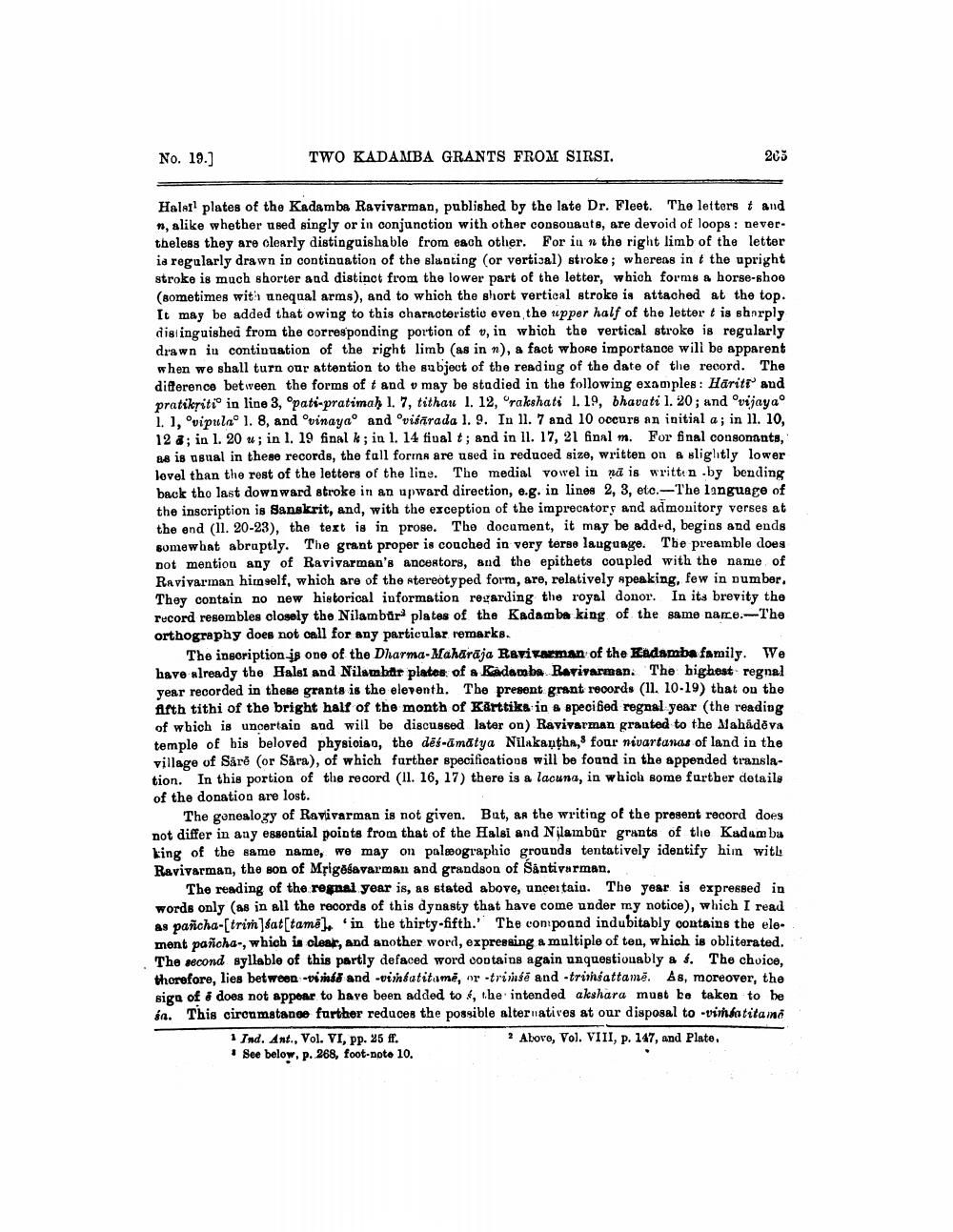________________
No. 19.)
TWO KADAMBA GRANTS FROM SIRSI.
205
Halatl plates of the Kadamba Ravivarman, published by the late Dr. Fleet. The letterst and ), alike whether used singly or in conjunction with other consonants, are devoid of loops : nevertheless they are clearly distinguishable from each other. For in n the right limb of the letter ia regularly drawn in continuation of the slapting (or vertical) stroke; whereas in t the upright stroke is much shorter and distinct from the lower part of the letter, which forms a horse-shoe (sometimes with unequal arms), and to which the short vertical stroke is attached at the top. It may be added that owing to this characteristic even the upper half of the letter t is sharply disiinguished from the corresponding portion of v, in wbich the vertical stroke is regalarly drawn in continuation of the right limb (as in n), a fact whore importance will be apparent when we shall turn our attention to the subject of the reading of the date of the record. The difference between the forms of t and v may be studied in the following examples: Hāritr and pratikritio in line 3, Opati-pratimah 1. 7, tithau I. 12, "rakshati 1. 19, bhavati l. 20; and vijayao 1. 1, vipulo 1. 8, and "vinayao and visārada 1. 9. In 11. 7 and 10 occurs an initial a; in 11. 10, 12 a; in l. 20 u; in l. 19 final k; in 1. 14 final t; and in ll. 17, 21 final m. For final consonants, 88 is usual in these records, the fall forms are used in reduced size, written on & slightly lower level than the rest of the letters of the line. The medial vowel in nā is written by bending back the last downward stroke in an upward direction, e.g. in lines 2, 3, etc. The language of the inscription is Sanskrit, and, with the exception of the imprecators and admonitory verses at the end (11. 20-23), the text is in prose. The document, it may be added, begins and ends somewhat abruptly. The grant proper is couched in very terse language. The preamble does not mention any of Ravivarman's ancestors, and the epitheta coupled with the name of Ravivarman himself, which are of the stereotyped form, are, relatively speaking, few in number, They contain no new historical information regarding the royal donor. In its brevity the record resembles closely the Nilambor plates of the Kadamba king of the same narce.--The orthography does not call for any particular remarks.
The inscription is one of the Dharma-Mahārāja Ravivarman of the Kadamba family. We have already the Halsi and Nilambor plates of a Kadambs Ravirarman. The highest regnal year recorded in these grants is the eleventh. The present grant records (11. 10-19) that on the fifth tithi of the bright half of the month of Kärttiks in a specified regnal year (the reading of which is uncertain and will be discussed later on) Ravivarman granted to the Mahādēva temple of his beloved physician, the des-āmātya Nilakantha,' four nivartanas of land in the village of Sare (or Sára), of which further specifications will be found in the appended translation. In this portion of the record (11. 16, 17) there is a lacuna, in which some further details of the donation are lost.
The genealogy of Ravivarman is not given. But, as the writing of the present record does not differ in any essential points from that of the Halsi and Nilambur grants of the Kadamba king of the same name, we may on paleographic grounds tentatively identify hin with Ravivarman, the son of Mrigosavarman and grandson of Santivarman.
The reading of the regnal year is, as stated above, uncertain. The year is expressed in words only (as in all the records of this dynasty that have come under my notice), which I read as pañcha-(trimsatstamol. in the thirty-fifth. The compound indubitably contains the ele. ment pañcha-, which is clear, and another word, expressing a multiple of ten, which is obliterated. The second syllable of this partly defaced word contains again unquestiouably a s. The choice, therefore, lies between -vimid and -vinnéatitamė, or -trims and tritsattame. As, moreover, the siga of a does not appear to have been added to the intended akshara must be taken to be sa. This circumstanse further reduces the possible alternatives at our disposal to -vinfatitame 1 Ind. Ant., Vol. VI, pp. 25 ff.
*Aboro, Vol. VIII, p. 147, and Plate, • See below. p. 268, foot-note 10.




